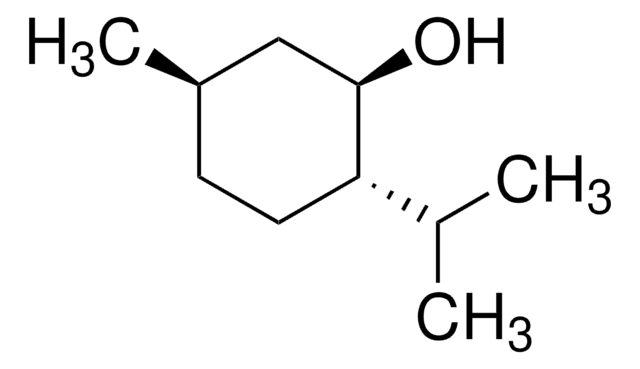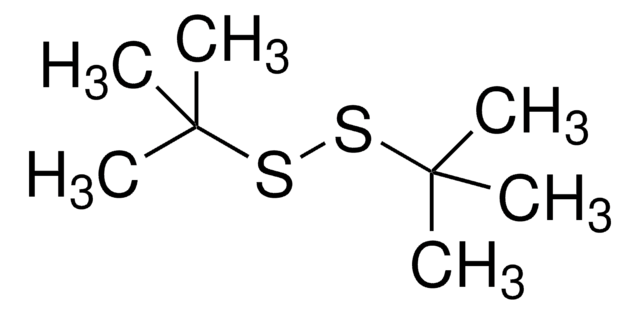149225
Dipropyl disulfide
98%
Synonym(s):
Propyl disulfide
Sign Into View Organizational & Contract Pricing
All Photos(1)
About This Item
Linear Formula:
CH3CH2CH2SSCH2CH2CH3
CAS Number:
Molecular Weight:
150.31
Beilstein:
969200
EC Number:
MDL number:
UNSPSC Code:
12352100
PubChem Substance ID:
NACRES:
NA.22
Recommended Products
Quality Level
Assay
98%
form
liquid
refractive index
n20/D 1.497 (lit.)
bp
195-196 °C (lit.)
mp
−86 °C (lit.)
density
0.96 g/mL at 25 °C (lit.)
functional group
disulfide
SMILES string
CCCSSCCC
InChI
1S/C6H14S2/c1-3-5-7-8-6-4-2/h3-6H2,1-2H3
InChI key
ALVPFGSHPUPROW-UHFFFAOYSA-N
Looking for similar products? Visit Product Comparison Guide
Related Categories
General description
Dipropyl disulfide (DPDS) was an efficient scavenger of reactive oxygen species (ROS) at a lower concentration in both HL-60 and HepG2 cells. It prevents the oxidative DNA damage caused by N-nitrosopiperidine (NPIP) and N-nitrosodibutylamine (NDBA).
Signal Word
Warning
Hazard Statements
Precautionary Statements
Hazard Classifications
Aquatic Chronic 2 - Eye Irrit. 2 - Skin Irrit. 2 - STOT SE 3
Target Organs
Respiratory system
Storage Class Code
10 - Combustible liquids
WGK
WGK 3
Flash Point(F)
147.2 °F - closed cup
Flash Point(C)
64 °C - closed cup
Personal Protective Equipment
dust mask type N95 (US), Eyeshields, Gloves
Choose from one of the most recent versions:
Already Own This Product?
Find documentation for the products that you have recently purchased in the Document Library.
Customers Also Viewed
C Teyssier et al.
Drug metabolism and disposition: the biological fate of chemicals, 28(6), 648-654 (2000-05-23)
The metabolism of dipropyl disulfide (DPDS), an Allium sulfur compound, was investigated in rat liver cell subfractions and in an isolated perfused rat liver. DPDS is oxidized to dipropyl thiosulfinate (DPDSO) by rat microsomes. The contribution of cytochrome P450 enzymes
Han-Seung Shin et al.
Journal of agricultural and food chemistry, 50(26), 7684-7690 (2002-12-12)
Organosulfur compounds and sodium bisulfite significantly inhibited (P < 0.05) heterocyclic aromatic amine (HAA) formation in model systems containing phenylalanine, creatinine, and glucose. There was, however, no inhibition by the same compounds in a model system containing only phenylalanine and
S G Sundaram et al.
Biochimica et biophysica acta, 1315(1), 15-20 (1996-01-17)
Diallyl disulfide (DADS), an oil-soluble organosulfur compound in processed garlic, was more effective in inhibiting the in vitro growth of human tumor cell lines: HCT-15 (colon), A549 (lung), and SK MEL-2 (skin) than isomolar quantities of the water-soluble compound S-allyl
Opender Koul
Journal of economic entomology, 97(3), 1142-1147 (2004-07-29)
Head space volatiles, including 73% di-n-propyl disulfide, were collected from freshly crushed neem seeds. This compound along with previously reported diallyl disulfide (di-2-propenyl disulfide) were toxic when applied topically or as a fumigant to Tribolium castaneum adults and 8-, 12-
Małgorzata Iciek et al.
European journal of pharmacology, 569(1-2), 1-7 (2007-06-15)
The present in vivo studies demonstrated that diallyl disulfide (DADS), occurring in garlic, elevated hepatic sulfane sulfur level and activities of gamma-cystathionase and 3-mercaptopyruvate sulfotransferase in healthy mice but did not affect the hepatic glutathione level. DADS efficiently corrected the
Our team of scientists has experience in all areas of research including Life Science, Material Science, Chemical Synthesis, Chromatography, Analytical and many others.
Contact Technical Service










